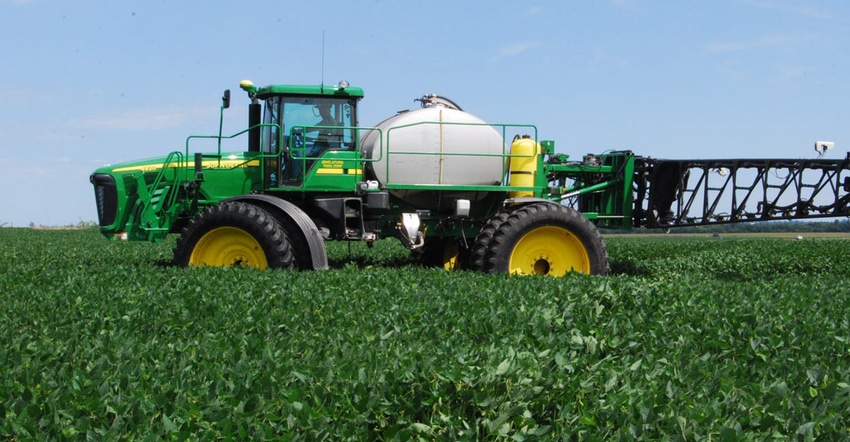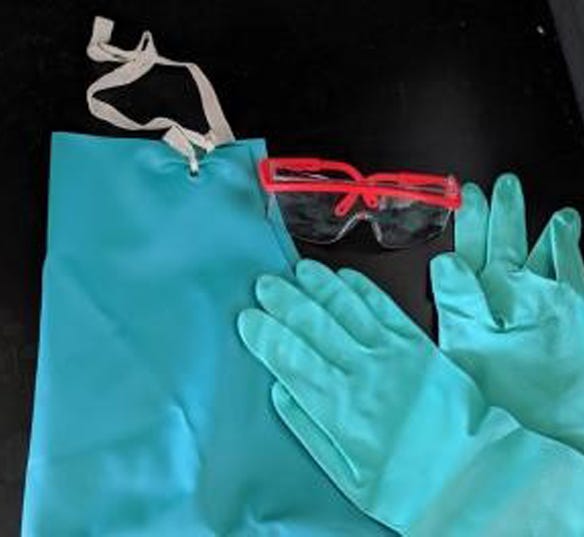July 24, 2019

When selecting a pesticide, make sure you read the label to ensure you have the personal protective equipment (PPE) needed to mix, load and apply that product.
PPE includes gloves, an apron, chemical-resistant footwear, coveralls and chemical-resistant suits, chemical-resistant headgear, protective eyewear and respirators. PPE is worn to protect your body from contact with pesticides and can best reduce exposure when worn correctly and maintained properly.
“Wearing and using the personal protective equipment reduces exposure but does not eliminate it,” says Betsy Buffington, an Iowa State University Extension pesticide safety specialist. “The pesticide label lists what PPE must be worn. PPE may vary depending on the specific task. Be sure to review the relevant PPE requirements for mixing, loading and/or handling in the precautionary statements section of the pesticide product label.”
Wear proper clothing, take precautions
If the label does not refer to PPE, use a minimum of protection, such as a long sleeve shirt, long pants, shoes, socks and waterproof gloves, she advises. You may choose to wear more PPE than the label requires. If two or more pesticides are used at the same time, you must use the PPE from the pesticide label that is most restrictive or that requires the most protective PPE. Buffington offers the following recommendations.

IT’S IN YOUR HANDS: Gloves, footwear, coveralls, headgear, eyewear, etc., can best protect you when worn correctly and used properly.
Gloves. Your hands and forearms get the most exposure from pesticides. Gloves must be the type specified on the pesticide product labeling. When “chemical-resistant” gloves are listed on the label, it is referring to PPE that is made of a material that allows no measurable movement of the pesticide being used through the material during use. Do not wear lined gloves because the lining can absorb pesticides. However, separate glove liners may be worn beneath chemical-resistant gloves.
If you must remove your gloves during a handling activity, wash the gloves thoroughly before taking them off. Then wash your hands thoroughly and dry them before touching anything, and put the gloves on again when you return to work. Keep several pairs of gloves available and change to a clean set whenever they become damaged or contaminated.
Be careful not to allow pesticide to run down your sleeves into your gloves. For jobs in which your arms are mostly lowered, place your sleeves outside the gloves. For jobs in which your arms are mostly raised, leave your gloves outside your sleeves. Fold the cuff of your gloves up 1 or 2 inches to catch the pesticide before it runs down your arm. For some jobs, your arms will be raised some of the time and lowered other times. In these cases, close the glove cuff tightly around the end of the glove where it meets the sleeve.
Aprons. The label may require a chemical-resistant apron when mixing and loading a pesticide. The apron must be long enough to cover the front of your body from mid-chest to knees.
Footwear. Chemical-resistant boots, shoes or shoe coverings, which prevent shoes from becoming contaminated, should be worn for pesticide work. Put your pant legs outside your boots to prevent pesticides from funneling onto your foot.
Coveralls and chemical-resistant suits. Coveralls and chemical-resistant suits must be loose-fitting, one- or two-piece garments that cover, at a minimum, the entire body except for your head, hands and feet. When the pesticide label requires coveralls to be worn, it means cloth garments. They are not required to be chemical-resistant. If full-body chemical-resistant protection is required, the label will specify a chemical-resistant suit instead of coveralls.
Headgear. When chemical-resistant headgear is specified by the product labeling, it must be either a chemical resistant hood or a chemical-resistant hat with a wide brim. Do not wear hats, such as baseball caps, when handling pesticides.
Protective eyewear. When “protective eyewear” is specified by the product labeling, one of the following types of eyewear must be worn: goggles; face shield; safety glasses with front, brow and temple protection; or a full-face respirator. Some labels specify that a particular type of eye protection must be worn.
Respirators. When a respirator is specified by the product labeling, it must be appropriate for the pesticide product used and for the activity to be performed. Use only respirators approved by the National Institute of Occupational Safety and Health (NIOSH).
Special requirements for respirator use
Before you can use a respirator, you must receive a medical evaluation by a physician or other licensed health care professional. Medical clearance is only required once unless medical problems arise, or a fit test indicates a need for re-evaluation.
You must also receive fit-testing with a taste, smell and irritating indicator, or with quantitative measurements. An annual fit test is required for all tight-fitting respirators when required by the pesticide label.
Finally, before using a respirator, you must receive training about the use, care and maintenance of the respirator. Respirator training is required annually or when workplace conditions change, or a new type of respirator is used. Records and documentation of medical clearance, fit-testing and training must be maintained for at least two years. Additional information on respirators can be found in the Worker Protection Standard Respiratory Protection Guide published by the Pesticide Educational Resources Collaborative.
Source: ISU, which is responsible for information provided and is wholly owned by the source. Informa Business Media and subsidiaries aren’t responsible for any content in this information asset.
You May Also Like




